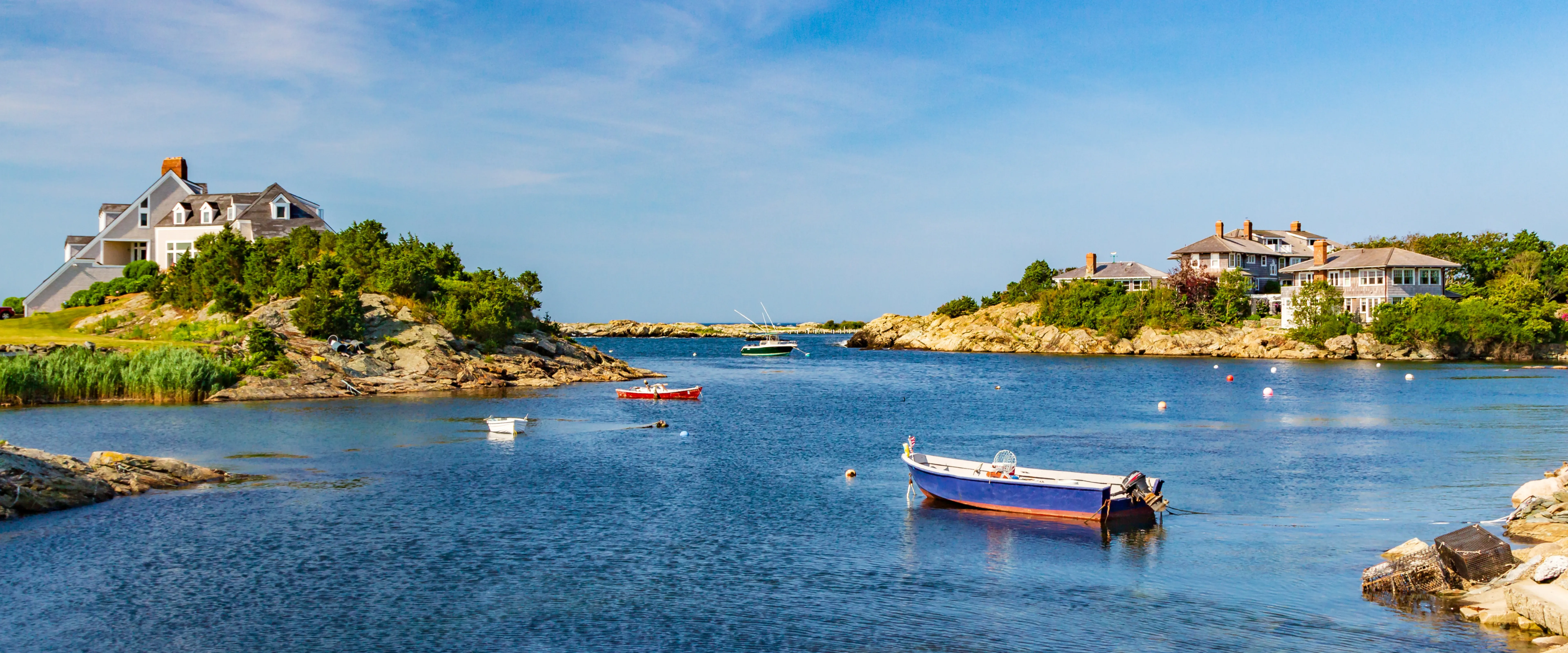
Rhode Island: The Tiny Northeast State With a Big Personality
Both heartachingly beautiful and different-drummer quirky, Rhode Island is the smallest of the United States and one of its most underestimated. While you weren’t looking, the state has created experiences so wide-ranging that you can loaf on the beach, commune with spirits in a haunted cemetery, dine at an Indigenous restaurant, and watch a woman juggle fire on the prow of a river gondola—all over the course of a single vacation.
Would you expect anything less from a state founded by a minister that Puritan leaders considered so outlandish they banished him from Massachusetts? A place whose official name was the State of Rhode Island and Providence Plantations until 2020, when its first female governor dropped the racist parts? A destination that installed giant sculptures of baked stuffed clams in airports to court tourism and just declared its fresh new marketing slogan to be “All That”?
Let us ask not about the bag of chips, but instead ask what makes the “biggest little state in the union”—a place so proud of its calamari, it practically hijacked the 2020 Democratic National Convention with a plate of squid rings—so full of personality. For all its diminutive size, Rhode Island’s allure casts a long shadow, thanks to outdoor recreation along 400 miles of coastline, a capital city with more than a dozen distinct neighborhoods, and a multitude of culinary choices, from classic Italian to soul food, that reflect the state’s deep history of sheltering diverse communities.
It’s not called the Ocean State for nothing

Rhode Island’s nickname derives from its coast, which was crucial to the state’s development. Today, tourism along its 100 beaches is a major economic driver. East Beach in Watch Hill (down the dunes from Taylor Swift’s waterfront mansion), Fred Benson Town Beach on Block Island, and Rocky Point State Park, on the grounds of a late, lamented amusement park, have the prettiest views.
Take a sailing tour in Newport or a gondola ride in Providence. Kayak scenic rivers, bays, and inlets, like Upper Wood River in Exeter and Napatree Point near Watch Hill. Scuba dive to shipwrecks, especially around Jamestown and Block Island. Or go quahogging at Point Judith. The shells of the quahog, an eastern species of clam, were used by the Indigenous Narragansetts as wampum (currency), and the meat became an iconic Rhode Island food after the catastrophic Hurricane of 1938 wiped out infrastructure for the more popular oyster industry.
Prefer to be near the water but not in it? Head for the Newport Cliff Walk, go biking around Block Island, or pedal a six-mile section of a historic railroad in Portsmouth via rail bike.
Gilded Age excess

Rhode Island was one of the wealthiest states per capita in the 18th and 19th centuries, in no small part because of trade through Newport—which included both enslaved people and goods like rum, whale-oil candles, and fine furniture. The city’s affluence drew Gilded Age glamourati, who built “summer cottages” along Newport’s shores. Guided tours of the mansions highlight everything from the lives of servants to filming locations for the Max series “The Gilded Age.”
If you BYOB (bring your own boat) or charter a vessel, you’ll get a peek at the many lesser-known historic homes clustered along the shores of Greenwich and Narragansett bays. Among them is Aldrich Mansion in Warwick, the setting of the 1998 Brad Pitt drama Meet Joe Black.
Spooky stories and legends

A turbulent social history—which includes slavery and colonial settlement, military battles, organized crime, and tragic love stories—has made Rhode Island a hotbed of spooky tales and legends. Walk in the footsteps of masters of horror Edgar Allan Poe and H. P. Lovecraft at the Providence Athenaeum. Or stroll the haunted halls of the Major General Nathanael Green Homestead in Coventry, where caretakers have reported phenomena like the ghostly clip-clop of horse’s hooves and a baby carriage that relocated itself after the house was closed for the evening.
North Burial Ground in Providence is a 110-acre, wildlife-filled green space and the resting place of various Revolutionary and Civil War heroes, enslaved people, Indigenous people, and immigrants. The cemetery hosts live music, ghost tours, and a Dia de los Muertos celebration.
Even wilder lore surrounds the grave of Mercy Brown in Exeter. A tuberculosis outbreak in the 1880s took the lives of Mary Brown and her two daughters, Mary Olive and Mercy; son Edwin took ill soon after. A group of superstitious townspeople blamed a vampire for draining the life out of the family. They exhumed the bodies of the three women and found Mercy’s to be unexpectedly well preserved. Assuming she was the demon in question, they cut out her heart, burned it, and added some of the ashes to Edwin’s medicine. Not surprisingly, the boy died two months later.
Bringing the past into the present

Historical tours and museums aren’t the only way to get in touch with the Ocean State’s past, though there are plenty—Parasols and Pocket Watches, in particular, gives a detailed overview of the “mile of history” along Providence’s Benefit Street. Stay at Aloft in the city’s historic Innovation and Design District, where you can take a self-guided tour of the one-time “jewelry capital of the world.”
Meanwhile, the RI Computer Museum in Warwick is a trove of tech artifacts, from calculators you probably haven’t seen since junior high to a late-1970s Pixar Image Computer. The collection is so rare that Hollywood productions like Hidden Figures and Halt and Catch Fire often turn to the museum to borrow vintage tech.
Explore unexpected art

In addition to the RISD Museum, which spans 100,000 pieces from the ancient to the modern, former industrial powerhouse Providence is full of manufacturing plants adapted into creative spaces. You’ll find three in the historically underserved, but now up-and-coming, Valley neighborhood. The Steel Yard offers exhibits and classes in welding, blacksmithing, jewelry, and ceramics. Teatro ECAS, opened in 2023, is New England’s only all-Spanish-language theater venue. A quarter-mile away, WaterFire Arts Center mounts contemporary exhibits and live performances, including on its rooftop bar.
The Arts Center is an offshoot of WaterFire, an award-winning sculpture-and-soundscape installation that rings the three rivers of Providence in fire once a month from April through November. When it debuted 30 years ago in the once-downtrodden downtown, WaterFire became a beacon of revitalization, attracting new businesses and thinkers to the city.
Retail therapy for the soul
Forego tourist traps like Thames Street in Newport for idiosyncratic stores and indie boutiques. Antique shops in historic Chepachet Village in the northern end of the state sell everything from estate jewelry to furniture, décor, and nostalgia-inducing penny candy like red licorice wheels and root beer barrels.
Some of the best shopping can be found along Hope, Wickenden, and Westminster streets in Providence, which stock clothing, accessories, housewares, gifts, books, and more. Plan your trip over a Sunday afternoon and browse Providence Flea, when 70 unusual vendors take over a chunk of District Park.
Quaint waterfront communities

Strike up a conversation with native Rhode Islanders, and you might ask yourself: What is that accent—Brooklynese? Bostonian? Downeast Mainer mixed with…Tony Soprano?
The English who colonized New England spoke a mix of dialects from Elizabethan London and rural Yorkshire and Lancashire. Throughout the 18th to early 20th centuries, an influx of immigrants—especially Italians, Irish, and Portuguese—incorporated their own pronunciations. This resulted in unique speech patterns, cheekily dubbed “Rhodonics,” which began in the waterfront communities where the newcomers first settled.
Stroll the streets of the Point neighborhood in Newport to see the largest concentration of colonial homes in the country. Party patriotically in Bristol, which runs the oldest continuous Fourth of July celebration starting in late May and culminating with a gala parade on Independence Day. Or visit bite-sized Pawtuxet Village on the Providence River for a mix of shopping, dining, and waterfront wandering.
Diverse cultures and cuisines
Rhode Island’s restaurants are surprisingly varied—another nod to its melting-pot heritage—especially in Providence, its most diverse city. You’ll find Peruvian and Bolivian specialties; Southern food; Uyghur dumplings and noodle bowls; a chic cafe serving modern Puerto Rican favorites; a maker of over-the-top, brioche-style doughnuts; and a distillery that crafts spirits from local ingredients like oysters. The Crime and Cuisine tour highlights the culinary history of Federal Hill, the city’s “Little Italy,” and its past connection to the third-largest Mafia presence in the country.
There are plenty of top-notch restaurants outside the capital. At Sly Fox Den Too in Charlestown, award-winning Mashpee Wampanoag chef Sherry Pocknett spins recipes around Indigenous ingredients. The Kitchen at the Surf Shack, a stylish Narragansett bed and breakfast, features French Polynesian‒style dishes. And Tuxpan Taqueria in Central Falls serves authentic Mexican street food so good you’ll contemplate stopping there for all your meals.
Little Rhody also has an outsized number of delicacies you can only find within its borders. Make a beeline to the coast for clam cakes, savory fritters studded with chunks of fresh clam; Iggy’s Doughboys and Chowder House and Aunt Carrie’s serve some of the best. Find a Dave’s Fresh Marketplace, and pick up a box of party pizza, rectangular strips of focaccia smothered with tomato sauce and herbs; pepper biscuits, crunchy, ring-shaped dough twists flavored with black pepper and fennel; and Autocrat coffee syrup, which you can add to milk or even cocktails. Don’t forget the Del’s frozen lemonade—which tastes even better with a couple splashes of vodka.
Good to know
Is Rhode Island expensive?
Rhode Island can easily be done on a budget, especially if you like camping. But once you start getting close to the coast, expect prices to rise. A lot. Hotels, on the whole, are not budget, unless you're willing to put up with lower-tier chains. Expect $150 per night for a boutique hotel in Providence and $200+ per night in Newport. When it comes to food, an entree at a sit-down restaurant runs $10–$20.
Best time to visit Rhode Island
April–June can be rainy, but temperatures are still pleasant. July–September are the warmest months, while October and November have stunning fall foliage.
Rhode Island with kids
Kids will love the beaches, parks, and spooky lore. Adults will enjoy exploring quaint communities, shopping, and world-class culinary offerings.
Rhode Island public transportation
You’ll find buses and trains in larger cities, like Providence, but you will need to rent a car to get out into the countryside or the coast.
Is Rhode Island safe?
Rhode Island ranks #9 for safety in the US, according to Vision of Humanity’s Global Peace Index. Most cities and towns are safe, even for solo travelers. But exercise caution with your belongings in crowded places, and avoid the occasional sketchy neighborhood.
Rhode Island also ranks #3 with a score of 85/100 for LGBTQ+ equality, according to Equaldex's LGBT Equality Index. Overall, Rhode Island is very LGBTQ-friendly, especially during Pride celebrations in June. You’ll find larger LGBTQ+ communities in cities like Providence, Newport, Wickford, Bristol, and Barrington.
Getting to Rhode Island
- Main airport: PVD
- Average Going deal price for cheap flights to Rhode Island: $162 roundtrip
More East Coast destinations:
Last updated August 5, 2024









